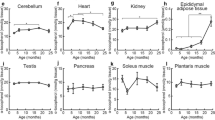Abstract
The biologic availability of two kinds of tocomonoenols, marine-derived tocopherol (MDT) and α-tocomonoenol, was investigated in ICR mice. Vitamin E-deficient ICR mice were fed MDT and α-tocomonoenol together with α-tocopherol, β-tocopherol, γ-tocopherol, and δ-tocopherol, and storage in liver, spleen, lung, and brain was quantified using reverse-phase high-performance liquid chromatography. The vitamin E relative biologic availability (VE-RBA) in liver was 100 for α-tocopherol, 26 ± 3 for β-tocopherol, 4 ± 2 for γ-tocopherol, not detected for δ-tocopherol, 49 ± 6 for MDT, and 30 ± 7 for α-tocomonoenol. The VE-RBA in brain was 100 for α-tocopherol, 5 ± 2 for β-tocopherol, not detected for γ-tocopherol and δ-tocopherol, 8 ± 1 for MDT, and 4 ± 1 for α-tocomonoenol. Tocopherols and tocomonoenols did not accumulate in the spleen or lung. MDT and α-tocomonoenol had high VE-RBA values. The VE-RBA value for MDT was much higher than that for β-tocopherol.






Similar content being viewed by others
Abbreviations
- ECD:
-
Electrochemical detector
- FL:
-
Fluorescence detector
- MDT:
-
Marine-derived tocopherol
- α-TTP:
-
α-Tocopherol transfer protein
- VEHTM:
-
Vitamin E homologues and tocomonoenols mixture
- VE-RBA:
-
Vitamin E relative biologic availability
References
Evans HM, Bishop KS (1922) On the existence of a hitherto unrecognized dietary factor essential for reproduction. Science 56:650–651
Fennema OR (1996) Food Chemistry, 3rd ed. Marcel Dekker, New York, pp 553–557
Packer L, Traber MG, Kraemer K, Frei B (2002) The antioxidant vitamin C and E. AOCS Press, Champaign, pp 133–151
Brigelius-Flohe R, Traber MG (1999) Vitamin E: function and metabolism. FASEB J 13:1145–1155
Matsumoto A, Takahashi S, Nakano K, Kijima S (1995) Identification of new vitamin E in plant oil. J Jpn Oil Chem Soc 44:593–597
Yamamoto Y, Maita N, Fujisawa A, Takashima J, Ishii Y, Dunlop WC (1999) A new vitamin E (α-tocomonoenol) from eggs of the pacific salmon. J Nat Prod 62:1685–1687
Mg MH, Choo YM, Ma AN, Chuah CH, Hashim MA (2004) Separation of vitamin E (tocopherol, tocotrienol, and tocomonoenol) in palm oil. Lipids 39:1031–1035
Yamamoto Y, Fujisawa A, Hara A, Dunlop WC (2001) An unusual vitamin E constituent (α-tocomonoenol) provides enhanced antioxidant protection in marine organisms adapted to cold-water environments. Proc Natl Acad Sci USA 98:13144–13148
Dunlop WC, Fujisawa A, Yamamoto Y, Moylan TJ, Sidell BD (2002) Notothenioid fish, krill and phytoplankton from Antarctica contain a vitamin E constituent (α-tocomonoenol) functionally associated with cold-water adaptation. Comp Biochem Physiol B Biochem Mol Biol 133:299–305
Dicks MW, Matterson LD (1961) Chick liver-storage bioassay of alpha-tocopherol: methods. J Nutr 75:165–174
Matterson LD, Pudelkiewicz WJ (1974) Relative potency of several forms of α-tocopherols in the chick liver storage bioassay. J Nutr 104:79–83
Leth T, Søndergaard H (1977) Biological activity of vitamin E compounds and natural materials by the resorption-gestation test, and chemical determination of the vitamin E activity in foods and feeds. J Nutr 107:2236–2243
Harris PL, Ludwig MI (1949) Relative vitamin E potency of natural and of synthetic α-tocopherol. J Biol Chem 179:1111–1115
Bunyan J, Green J, Edwin EE, Diplock AT (1960) Studies on vitamin E3. The relative activities of tocopherols and some other substances in vivo and in vitro against dilauric acid-induced haemolysis of erythrocytes. Biochem J 75:460–467
Hove EL, Harris PL (1947) Relative activity of the tocopherols in curing muscular dystrophy in rabbits. J Nutr 33:95–106
Sato Y, Hagiwara K, Arai H, Inoue K (1991) Purification and characterization of the α-tocopherol transfer protein from rat liver. FEBS Lett 288:41–45
Hosomi A, Arita M, Sato Y, Kiyose C, Ueda T, Igarashi O, Arai H, Inoue K (1997) Affinity for α-tocopherol transfer protein as a determinant of the biological activities of vitamin E analogs. FEBS Lett 409:105–108
Ghosh S, Bhattacharyya DK (1996) Isolation of tocopherol and sterol concentrate from sunflower oil deodorizer distillate. J Am Oil Chem Soc 73:1271–1274
Kim SK, Rhee JS (1982) Isolation and purification of tocopherols and sterols from soya oil deodorization. Korean J Food Sci Technol 14:174–178
Leonard OS, Terasawa Y, Farese RV Jr, Traber MG (2002) Incorporation of deuterated RRR- or all-rac-α-tocopherol in plasma and tissues of α-tocopherol transfer protein-null mice. Am J Clin Nutr 75:555–560
Vasu VT, Hobson B, Gohil K, Cross CE (2007) Genome-wide screening of alpha-tocopherol sensitive genes in heart tissue from alpha-tocopherol transfer protein null mice (ATTP−/−). FEBS Lett 581:1572–1578
Tanito M, Yoshida Y, Kaidzu S, Chen ZH, Cynshi O, Jishage K, Niki E, Ohira A (2007) Acceleration of age-related changes in the retina in α-tocopherol transfer protein null mice fed vitamin E deficient diet. Invest Ophthalmol Vis Sci 48:396–404
Mino M, Kitagawa M, Nakagawa S (1981) Changes of alpha-tocopherol levels in red blood cells and plasma with respect to hemolysis induced by dialuric acid vitamin E-deficient rats. J Nutr Sci Vitaminol 27:199–207
Behrens WA, Madère R (1991) Tissue discrimination between dietary RRR-α- and all-rac-α-tocopherols in rats. J Nutr 121:454–459
Ingold KU, Burton GW, Foster DO, Hughes L, Lidsay DA, Webb A (1987) Biokinetics of and discrimination between dietary RRR- and SRR-α-tocopherols in the male rat. Lipids 22:163–172
Burton GW, Wronska U, Stone L, Foster DO, Ingold KU (1990) Biokinetics of dietary RRR-α-tocopherol in the male guinea pig at three dietary levels of vitamin C and two levels of vitamin E. evidence that vitamin C does not “spare” vitamin E in vivo. Lipids 25:199–210
Acknowledgments
We thank Dr. Yasukazu Yoshida for valuable comments. This work was supported by a grant from Nippon Suisan Kaisha, Ltd., Japan.
Author information
Authors and Affiliations
Corresponding author
About this article
Cite this article
Gotoh, N., Watanabe, H., Oka, T. et al. Dietary Marine-Derived Tocopherol has a Higher Biological Availability in Mice Relative to Alpha-Tocopherol. Lipids 44, 133–143 (2009). https://doi.org/10.1007/s11745-008-3257-3
Received:
Accepted:
Published:
Issue Date:
DOI: https://doi.org/10.1007/s11745-008-3257-3




